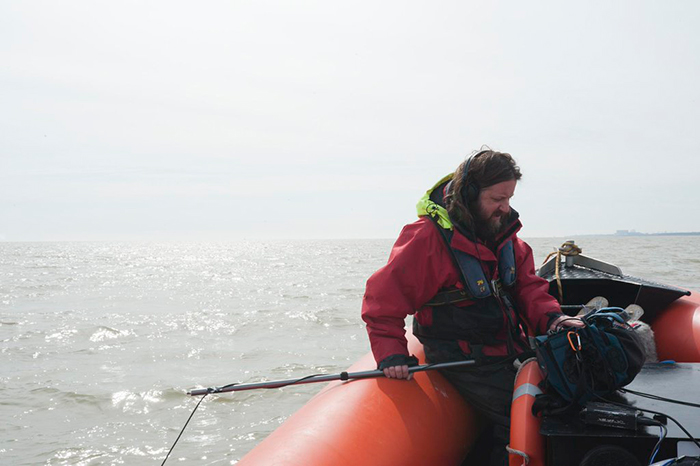By the Mark, the Deep is a collaborative sound work with artist Matt Davies that delves into the submerged ruins of the lost coastal town of Dunwich, which has been inundated over the centuries by storm surges flooding in from the North Sea. It was first installed at Spike Island in Bristol, and later went on to be incorporated into a wider programme of works accompanying Richard Long’s Time and Space at Arnolfini in 2015. The work was also performed live with Laura Cannell and Rhodri Davies.

Composed from underwater field recordings made in the waters covering the town, the piece drew on archaeological dive reports describing the lack of visibility during ground truthing exercises at the site. Recordings were made using a variety of hydrophones (aquatic microphones) suspended in the water column at various heights. Compositions formed from these recordings were played back via 12-channel speaker set-ups in gallery spaces, creating an immersive soundscape mimicking the subaqueous sonic dynamics of the ruins. Visitors were encouraged to enter the darkened space of the gallery and listen as the sound swirled around them, and to consider how landscapes act as repositories of cultural histories, narratives and identities, and the persistence of these in a changing world.
Arnolfini installation text:
Seen from the sea Dunwich reveals itself tentatively, more as a question than as something definite. The land rises indistinctly from the horizon, an eroding deposit of low shingle and weakly cemented sand. Thinly spaced but visible beyond the berths and wooden huts of the longshore fishermen are a few scattered houses and a single street. These are the remnants of what was once one of the largest ports in England; the town itself has been all but lost over the centuries, inundated by a series of storm surges flooding in from the sea. Its remains lie scattered and unfathomable on the seabed, resisting articulation as they are slowly buried by settling accumulations of sediment.
On the spring tide of the vernal equinox we anchored ourselves in position above the town, half a mile from the shore, the boat settling in the current and rising and falling with the rolling swell. At the turning point of the tide the sea slackened, changing quietly and flattening out; its surface scuffed occasionally by the wind. Looking over the side, the silt bloomed, turbid and cloudy, and scattering the gaze as it attempted to descend.
In the months leading up to this voyage we had read various reports made by divers descending to the submerged ruins on archaeological surveys. Each account described the poorness of the visibility; the gloominess of the water, yellow and thick with sediment, and how their ability to see deteriorated the deeper they went. By the time they neared the seabed eight meters down their sight was so restricted that even with the use of their torches they were reduced to fumbling around by sense of touch alone. There they described the strength of the currents that rushed and whirled around the site, the numerous smooth stone structures that littered it.
After these failures other attempts to map the remains had met more success; sonar arrays had been used to reflect bursts of sound off the seabed in order to form a detailed picture of its surface features. Listening to the returning echo of these sounds became a way to comprehend something of this place sightlessly, highlighting fragments of carved stone and piles of debris protruding from the growing bank of sand and fine sediment beginning to cover the town.
As we sat there in the boat listening to the submerged microphones, what was immediately audible was the muteness of the town itself. But the recordings were far from quiet; instead, the sounds we heard detached themselves from what was known, shifting amorphously and shimmering around the edges of the unseen remains below.
Unable to be verified by sight, the recordings brought forth another world; one that spoke to the imagination. They evoked a distorted territory that crackled, hissed, and drifted away from the silence; a deformation caused by the salt water and pressure acting on the microphones, short-circuiting and slowly destroying them, but leaving amongst the sound of decay the traces of recognizable things.